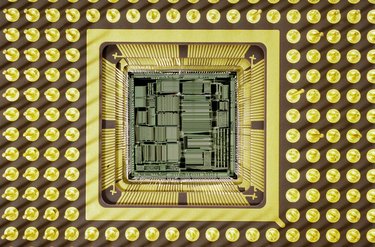
Most modern computing equipment has a microprocessor at its heart. The microprocessor gives a computer the ability to calculate, sort data and perform logical comparisons. The key distinguishing feature of a microprocessor is its integrated nature -- the way it combines several different circuits into a single package. Having the essential components in one device makes digital equipment -- including cellphones, personal computers and Web servers -- smaller, less expensive and easier to build.
Early Computers
Video of the Day
Before 1971, the year in which Intel engineers developed the first microprocessor, most electronic circuits were still made of discrete parts: individual transistors, resistors and capacitors. The computers made then used many of the same basic functional parts used today: a central processing unit (CPU) consisting of an arithmetic and logic unit (ALU), data and memory address registers, a program counter and other circuits. Each building block could consist of several circuit boards, each of which contained dozens of individual parts. The circuit boards plugged into a common chassis that carried electronic signals back and forth among them.
Video of the Day
Early Microprocessors
In the early 1970s, integrated circuits had improved to the point where each one had thousands of transistors, roughly the number needed to make a simple computer. Engineers created circuits implementing a computer's basic functions all on a single silicon chip. Instead of a computer that filled a cabinet, they created a computer in a single device that fit on your fingertip. By eliminating the thousands of soldered connections between the transistors in discrete circuits, engineers greatly improved the computer's reliability. Once they finalized the chip's design, factories could stamp them out by the millions, reducing costs by factors of up to 1,000.
Contemporary Microprocessor
In the decades following the 1970s, integrated circuit techniques have increased the number of transistors on a single chip from thousands to billions. Though microprocessors retain the same basic organization as before, they now have features such as multiple CPUs, high-speed memory and sophisticated power management. In addition to having more complex circuits, they have well over 1,000 times the processing power of the earliest devices.
SoC and Microcontroller
Two variations of the microprocessor, the system-on-a-chip (SoC) and the microcontroller, take the concept of integration further by putting more functional parts on the same chip. A single SoC may, for example, contain a microprocessor, radio signal circuitry and data memory. A somewhat older idea, the microcontroller, has a microprocessor, memory and circuitry to communicate with and drive external devices.